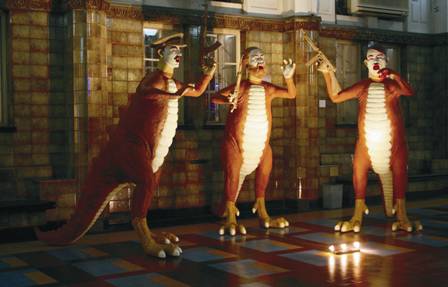 |
|
|---|---|
| CP Foundation | About CP Biennale | 2003 | 2005 | Contact Us | |
         
|
|
|
Pseudo Development's Ancestors Heri Dono was born on June 12,1960, in Jakarta, Indonesia, and is currently residing in Yogyakarta, Central Java, Indonesia. In 1987, he finished his study at the Indonesian Institute of the Arts (ISI) in Yogyakarta. Heri Dono has held numerous solo exhibitions in Indonesia and abroad. These include: “Free-D.O.M.” at the Hordaland International Art Gallery, Bergen, Norway (2005); “Who's Afraid of Donosaurus” at the National Gallery, Jakarta (2004); “Heri Dono”, Australian Print Workshop, Melbourne, Australia (2003); “Up Side Down Mind”, Circle Point Art Space, Washington DC, U.S.A (2003); “Heri Provokes Heri”, Nadi Gallery, Jakarta (2002); and “Fortress of the Heart”, Gajah Gallery, Singapore (2001). Since the beginning of his career in the ‘80s, Heri Dono has talked about urban problems. Like many other Indonesian painters, he has been interested in the urban lives of the grassroots. Heri Dono's perception about this group, however, is unique. He sees the group as a group able to enrich the culture in our urbanity. Heri Dono often creates collaborative works with people other than artists. This way, he feels that he is dealing with culture, and not merely with art. He, for example, works with used-radio sellers, as he sees that the effort to repair the used radios is a sign of culture. Heri Dono is entranced by the people's skills in improving the looks of these used radios. He sees that these sellers are basically masters of the art of crafting. Such skill, a combination of technical and artistic knowledge, has been brought with them from traditions, as they are still living closely with traditions. “This is contextual, as it exists only in Indonesia,” says Heri. That's the reason why he asks the radio repairmen to collaborate with him. Because, “The project we're making is a cultural project.” The 1960-born artist dislikes calling his work an art project. He thinks that the perception about art, the definition of art, and the discourse of art, have all been contaminated by perceptions that are true only for a small number of people. Heri Dono is sure that innovations in life do not take place merely in the art world; rather, they happen in the realm of culture. He shows an example from his collaboration with used-goods artisans who create toys and other functional objects from Coca-Cola cans. The objects they create are good, functional, and betray again the art of crafting. He therefore views the effort to re-use used objects as a highly useful innovation. “And this depicts progress. We can also see urban conditions in these objects,” Heri reasons. Before the collaboration, the artisans created toys and functional objects from stuff such as wood, coconut shells, and leaves. “When I took their works to an international forum, I wished to show how innovations take place in the Indonesian culture and around the grassroots,” thus Heri. “The goods they make are not perfect, indeed, but innovations are never perfect, after all. Perfection is a continuation of innovations with no novel values.” (Jim Supangkat) |
|
|
CP foundation | About CP Biennale | 2005 Biennale | 2003 Biennale | Contact Us
Jl. Suryopranoto 67A, Jakarta 10160, Indonesia. ph. +62.21.3448126, 3853206 | fax. +62.21.3853203, 3853208 info@cp-foundation.org |
